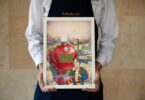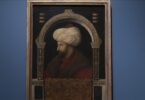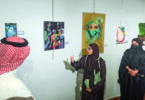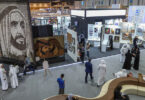Maan Jalal
When artist Saher Nassar was around six years old, soldiers came to his family home in Gaza.
They were looking for his uncle who, like many youngsters at the time, was active in some capacity in the first Palestinian Intifada, a civil uprising which began in 1987. The soldiers turned his uncle’s room upside-down, took what they wanted and seized his uncle. On their way out, they stood next to Nassar’s mother, who was baking bread and waited for it to be ready. Then they sat down, ate the bread and left.
“This was my first encounter with violence,” Nassar tells The National. “It was my first experience with the image of brutality, with the image of the regime – it was soldiers.”
His uncle was eventually released, but the incident and the images of the soldiers remained with Nassar. They are today the subject of his solo exhibition at Zawyeh Gallery in Alserkal Avenue. The Front Side Strikes The Most, curated by Giuseppe Moscatello, is focused on the universal idea of the soldier as a symbol of power.
Through his own observations and collations of stories, Nassar uses bright, bold colours, stylised figures and satire to depict enticing scenes. At first, the viewer is attracted to the work through his aesthetic, a pictorial language influenced by elements of pop art with a rich sense of play. But once the context of the scene makes itself apparent, the viewer must reassess what they’re looking at.
:quality(70)/cloudfront-eu-central-1.images.arcpublishing.com/thenational/S6W3NBYY4RCPRKXPQLUYKN4I3A.jpg)
In the work Trip to the Museum, a soldier interacts with a newborn on a stark yellow floor. Surrounding them are three paintings, each depicting female figures, reminiscent of Greek antique busts. A reference to Greek goddesses, the symbols are often used in art to represent grace, beauty and charm among other things. Here, they are used by Nassar to embody blood, milk and nature.
Nassar again uses recognisable cultural references in his series Target. Here, two children and a young woman stand in fear and anticipation with items – a Coke can, a Pringles box, a juice box – sitting on their head as a target.
In another work, Children of the Occupation No.1, a female soldier, scantily dressed in a pink apron and wearing a helmet, cracks an egg over a frying pan. Surrounded by the mess she has created in the kitchen, she stands faceless and watches her eggs fry in the pan, unattached and uninterested.
“I’m not trying as much to criticise the soldier as to analyse, to understand how they think,” Nassar explains.
“If soldiers are doing what they’re doing, they must believe what they’re doing is right. This is so funny to me. How would they reach this level? What makes them behave that way? My work tries to understand how this happens from many different perspectives. Sometimes I even sympathise with them.”
Nassar doesn’t only attempt to make sense of the soldier’s psychology in all its paradoxes, he also taps into how the public interact with these unnerving ideas. By using clever visual cues, he draws the viewer, then holds them in a state of shock, at times of horror, through the narrative implications of each work.
“Some people want to stay away from ideas of violence, of war, but I’m creating a trap,” he says. “It’s grabbing your attention, but then when you stare at the work you start feeling the pain in the work.”
Nassar grew up in Gaza and moved to Dubai in 2010. His family still live in Tal Alzaatar in northern Gaza, an area that has been heavily bombed in the past month.
“Every hour is a new situation. I check on my family in the morning, noon time, afternoon, sunset, at night,” he says. “Whenever there is a connection, of course. Constantly, they keep cutting off the communications.”
:quality(70)/cloudfront-eu-central-1.images.arcpublishing.com/thenational/YXB5QZEXS5CBVBRKGBNXPLR3LM.jpg)
Nassar’s solo exhibition opened on September 28, before the current conflict in the region began. And while there are some themes in his work that could be connected to what is currently happening to his homeland and people, Nassar sees the ideas and concepts he’s grappling with as part of a wider conversation about power structures and humanity.
“This work doesn’t relate exclusively to my case,” he says.
“I looked at wars, at regimes all across the globe, and I see these representations of corruption, of destruction embodied in the soldier. I did this show about soldiers because they are the forefront power of any regime.”
However, despite believing in the importance of art as a means to understand society, humanity and greater concepts about the world, Nassar is solemn in his belief that in times like these, art is futile.
“Art is irrelevant. Right now, there’s no art that can convey what’s happening,” he says.
“No music, no art, nothing works, nothing. In my opinion nothing makes sense until this is finished and then you talk about it.”
Courtesy: thenationalnews







